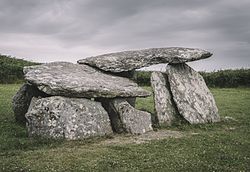Isle of Tear: Difference between revisions
m (spelling) |
|||
| Line 1: | Line 1: | ||
{{Infobox ancient site | {{Infobox ancient site | ||
| name = Isle of Tear <!-- required --> | | name = Isle of Tear <!-- required --> | ||
| Line 69: | Line 67: | ||
}} | }} | ||
The '''Isle of Tear''' ({{wp|Irish Language|Meallaigian}}: Tearmann or Oileán Tearmainn) is an island located just offshore of mainland [[Argis]] and is a ancient ceremonial and burial site near [[Goorey]] in [[Province of Lænighríh|Lænighríh]], [[Gotneska]]. Tradition identifies the island as the inauguration place and seat of the [[High Kings of Aideenn]]; it also appears in [[Cordic Mythology]]. | |||
== Name == | |||
The name Tear is a shortened form of the name Tearmann or Oileán Tearmainn (‘Isle of Tear’). It is also known as Tearmann na Ríthe (‘Tear of the Kings’), and formally also antOileán Órga (‘The Golden Island’) The {{wp|Old Irish|Old Meallaigian}} form is Teriair. It is believed this comes from the {{wp|Proto-Celtic|Proto-Geltic}} *Temrais and means ‘{{wp|Sanctuary}}’ or ‘sacred place’. | |||
The name Tear is shortened form of the name Tearmann or Oileán Tearmainn (‘Isle of Tear’). It is also known as Tearmann na Ríthe (‘Tear of the Kings’), and formally also antOileán Órga (‘The Golden Island’) The {{ | |||
==Features and Early History== | == Features and Early History == | ||
===Ancient monuments=== | === Ancient monuments === | ||
The island has remains of 26 ancient monuments that are still visible, and at least three times that many have been found through geophysical surveys and aerial photography. | The island has remains of 26 ancient monuments that are still visible, and at least three times that many have been found through geophysical surveys and aerial photography. | ||
The oldest visible monument is Carraig Dé (the ‘[[Rock of God]]’), a {{ | The oldest visible monument is Carraig Dé (the ‘[[Rock of God]]’), a {{wp|Neolithic}} {{wp|Standing Stone}}, built around {{circa|3500 BCE}}. | ||
=== | === Churches === | ||
===Roads of the Isle=== | === Roads of the Isle === | ||
==Significance== | == Significance == | ||
==Later History== | == Later History == | ||
[[Category:Gotneska]] | [[Category:Gotneska]] | ||
{{Eurth}} | {{Eurth}} | ||
Latest revision as of 17:21, 5 February 2023
Tearmann | |
 The Coronation Stone, located on the northern side of Isle of Tear | |
| Location | Province of Lænighríh, Gotneska |
|---|---|
| Altitude | 81 m (266 ft) |
| Type | Ceremonial and burial site |
| History | |
| Periods | Neolithic-Iron Age |
| Cultures | Cordic |
| Site notes | |
| Ownership | Currently the Gotneskan Government through the GNPA |
| Management | Gothian National Park Agency |
Invalid designation | |
| Official name | The Isle of Tear National Archaeological Monument |
| Designated | 1923 |
| Reference no. | 171 |
The Isle of Tear (Meallaigian: Tearmann or Oileán Tearmainn) is an island located just offshore of mainland Argis and is a ancient ceremonial and burial site near Goorey in Lænighríh, Gotneska. Tradition identifies the island as the inauguration place and seat of the High Kings of Aideenn; it also appears in Cordic Mythology.
Name
The name Tear is a shortened form of the name Tearmann or Oileán Tearmainn (‘Isle of Tear’). It is also known as Tearmann na Ríthe (‘Tear of the Kings’), and formally also antOileán Órga (‘The Golden Island’) The Old Meallaigian form is Teriair. It is believed this comes from the Proto-Geltic *Temrais and means ‘Sanctuary’ or ‘sacred place’.
Features and Early History
Ancient monuments
The island has remains of 26 ancient monuments that are still visible, and at least three times that many have been found through geophysical surveys and aerial photography.
The oldest visible monument is Carraig Dé (the ‘Rock of God’), a Neolithic Standing Stone, built around c. 3500 BCE.